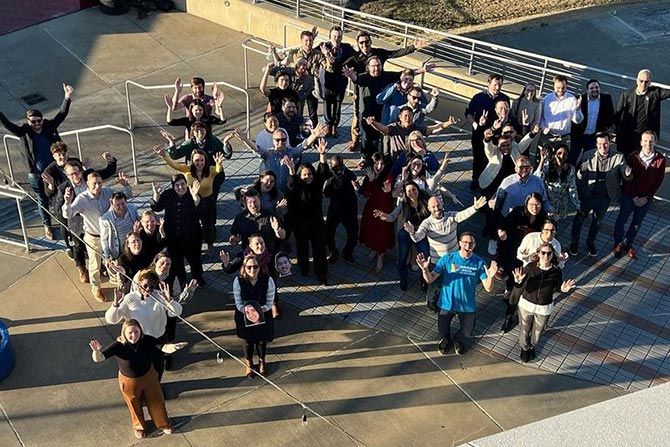Now retired, Charles “Charlie” Van Over, AIA, designed a legacy of thoughtful and purposeful buildings that are both beautiful and functional. His love of natural lighting was at the center of many of his buildings, focusing on healing the body and restoring the human spirit.
Charlie had a long and successful career, with the majority of his time spent at Plan One Architects. At the time of his retirement, he was the president of the firm. He was an active member of AIA WY and was a strong proponent of the association. He held the position of treasurer and was on the Government Advocacy Committee from its inception, helping to get it off the ground and he continues to serve on this committee. After retirement, he served as an AIA Juror for the Honor Awards in 2023.
The desire to acquire new skills and his love of learning has carried him well into retirement. He has taken up woodworking, carpentry and building ornate dollhouses that he uses to give back to and bless his friends, family and the community. Charlie often donates his work to charities, like Cowboys Against Cancer, to help raise money for those in need.
We recently sat down with him and learned more about his life, career and thoughts on the industry. Charlie was a delight to talk to, and we want to thank him for his time. The following are excerpts from our conversation.
When and why did you decide to become an architect?
I was born and raised in Glenwood Springs, Colorado. As a young child, I enjoyed drawing buildings and houses. During my late teenage years, I worked for a contractor where I learned how buildings are constructed, how to cut boards, how to place the studs 16 inches on center and how to build the trusses and floor joists. With that knowledge, I would draw up house plans and then build to-scale model stick-frame houses. That was very interesting for me.
While I was attending high school, I took several drafting classes and played team sports as well. I did well at both and ended up with an athletic scholarship. However, during my senior year, I was injured and sports were not an option anymore. So I changed my focus and put my efforts into drafting and architecture. Trinidad State Junior College offered a degree in drafting and architectural design and technology, and I applied for a scholarship there. I sent in examples of my drafting work along with a 3D drawing and was awarded a scholarship.
When I graduated, I found a job in Rock Springs, Wyoming, with Kellogg and Kellogg Architects. I started work with the idea that in six months I was getting the heck out of Rock Spring as that place was unbelievable. That was in 1975. Now I’m retired and I’m still living here, so I guess it grew on me.
Did any architect, in particular, inspire you?
The one nationally renowned architect that inspired me the most was Frank Lloyd Wright. I’ve hung on to a lot of philosophies that I took from his work, such as having as much natural light in a building as I could possibly get. I went to great lengths to make that happen, and that isn’t easy, especially in multi-story buildings. But I believe people work better and people are happier when they have natural light in their environment.
I’ve worked on many schools, and the project consultants always pointed out that people learn better with natural light. In Wyoming, school buildings are funded by the state. The State has a team of value engineers who critique designs and require elimination of perceived unnecessary items so they’re budget-friendly. It seemed they were always wanting to eliminate my skylights and my clear-story windows which drove me nuts. I won a few of those battles and lost a few.
I remember working on a medical facility where we relit the corridors from the outside. We had windows in the exam rooms, and of course, they had to be high enough for privacy. We put transoms above the doors so the natural light could come out into the hallways. I was always trying to think of things to enhance the experience throughout the building.
What is your favorite architectural style?
I love the Renaissance style, but you can’t realistically afford to build that way today. Most of my projects are more in the modernism style. I never wanted to design anything that was, per se, a monument to me. Every project and every building had to fit within its confines — it had to fit on the site and within the surrounding community.
If I had to add on to a building, I would do my best to find the same materials that were used in the previous construction and use the same style of architecture. I didn’t want it to look like it was an addition. It needed to look like it was part of the original construction.
What type of project do you enjoy designing most?
There are two types of projects I had the most fun with because they challenged my mind. First would be correctional work. I always had to be thinking: How do I keep the public safe? How do I keep the staff safe? But conversely, how do I keep the inmates or prisoners safe from themselves and each other. I was always having to think, if I do this, can somebody use it as a weapon or arm themselves? I always had to be thinking ahead and that really challenged my mind.
I designed the county jail in Basin, Wyoming. When it was finished, I remember somebody saying, “That is such a cool building. It actually looks like a library. I would never have known it was a jail.” That was a huge compliment.
The second type of project I enjoyed was healthcare. Healthcare is something that is forever changing. In Wyoming, buildings go in cycles. The jails were built in the 40s and 50s, and now don’t comply with current standards. So now we are rebuilding all the jails. Hospitals were designed during the same period and medicine isn’t done the way it was back then. So we would get a hospital building with all these empty rooms because today everything is outpatient as much as possible. I had to figure out how to adapt the unused spaces into useful space that worked with current practice. It was challenging in a different way because you’re trying to help people and build an environment that is good for healing, which again, includes natural light, in my opinion.
Which architectural projects have been your favorites?
That’s hard because there were so many, and each one has merit. If I had to pick, I’d say the restoration of the Wyoming State Capitol. I was on a team hired for the project. I was the Wyoming resident Architect. I was very involved in the early planning, schematic design and all of the studies and the historical research. It was over a $300 million project. It’s very rewarding to go see it now that it’s completed.
What career accomplishment are you proudest of?
I’m really proud that, at one time, Plan One was the largest firm in the state and had 30+ employees. Another would be my body of work and its diversity. Throughout my career, I learned that designing a building is almost like developing a child. From the very beginning, you can see this building based on what the owner has told you and their requirements. You come up with the design, the building gets built, and then you get to see people enjoying it as it was intended.
What is the most important lesson you learned over your career?
You need to be a good listener. I would take somebody with me in the early stages of meeting with clients. That person would take notes so I could concentrate on gathering the information from the client that I needed to be successful. So often, projects go wrong because somebody didn’t listen to the clients’ needs and wishes or didn’t fully understand them.
I also learned that there are so many new products on the market and everybody claims that the products are better than what they used to be. I always took the time to research a product before I would buy into it wholesale. It may look pretty, it may be really nice, but it may only last 5-10 years, and then it would have to be replaced. Longevity is a key component for client satisfaction.
What advice would you give to a young architect?
To be successful, you have to have a willingness and eagerness to learn and be a good listener. Being flexible, adaptable and patient is also important. I have had multiple projects that took many years to actually see them to completion. Continuing to assist my clients in any way I could and working with them was well worth it.
In this profession, you’ve got to be able to think on your feet. When you get a phone call from a contractor saying, “Hey, this just happened,” or “We did this, and this isn’t going to work,” how do you solve that problem? You don’t have days and weeks to figure it out. You’ve got to be able to come up with a solution rather quickly.
All in all, the Architectural profession was very rewarding and I thoroughly enjoyed it. Now I am thoroughly enjoying retirement, traveling, my family and grandkids.










